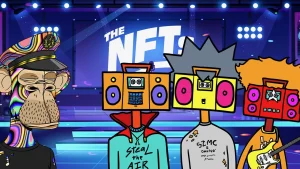Art /Entertainment
The Role of NFTs in Collecting Movie Memorabilia

Introduction
In an age where digital innovation intersects with traditional collecting, Non-Fungible Tokens (NFTs) have emerged as a game-changer in the world of movie memorabilia. These unique digital assets, underpinned by blockchain technology, are redefining how fans and collectors acquire, trade, and authenticate iconic pieces from their favorite films. This article delves into the transformative role of NFTs in collecting movie memorabilia, exploring their benefits, challenges, and future potential.
Understanding NFTs and Their Unique Characteristics

Image by: Yandex.com
NFTs, or Non-Fungible Tokens, are digital assets that represent ownership of a unique item or piece of content, verified through blockchain technology. Unlike cryptocurrencies such as Bitcoin or Ethereum, which are fungible and can be exchanged on a one-to-one basis, NFTs are unique and cannot be exchanged like-for-like. This uniqueness makes them ideal for representing ownership of rare and valuable items, such as movie memorabilia.
The Intersection of NFTs and Movie Memorabilia

Image by: Yandex.com
Movie memorabilia encompasses a wide range of items, from props and costumes to posters and scripts. Traditionally, these items have been physical objects, often requiring meticulous care and authentication processes. NFTs bring a new dimension to this field by offering digital representations of these items, complete with verifiable ownership and provenance.
Benefits of NFTs in Movie Memorabilia Collecting
- Authenticity and Provenance: One of the primary challenges in collecting movie memorabilia is ensuring authenticity. With NFTs, each token is linked to a specific item and recorded on the blockchain, providing an immutable record of ownership and history.
- Accessibility: NFTs make it possible for fans and collectors worldwide to own a piece of movie history without the need for physical storage or transportation. This democratizes access to movie memorabilia, allowing more people to participate in the market.
- Fractional Ownership: NFTs enable fractional ownership, where multiple individuals can own a share of a single piece of memorabilia. This is particularly beneficial for high-value items, making them more accessible to a broader audience.
- Enhanced Engagement: NFTs can be integrated with digital experiences, such as virtual galleries or augmented reality (AR) displays, enhancing the way collectors interact with their memorabilia.
Case Studies: NFTs in Movie Memorabilia

Image by: Yandex.com
Several high-profile examples illustrate the growing trend of using NFTs in the movie memorabilia market:
- Star Wars Digital Collectibles: The iconic Star Wars franchise has embraced NFTs by releasing digital collectibles, including limited-edition posters and character cards. These NFTs come with unique animations and sound effects, adding a new layer of engagement for fans.
- Back to the Future Hoverboard: An NFT representing the famous hoverboard from Back to the Future was auctioned, complete with a digital certificate of authenticity and a 3D model of the hoverboard. This NFT allowed fans to own a piece of cinematic history in a digital format.
- The Godfather Script: A rare digital copy of the original script for The Godfather was tokenized as an NFT. This not only preserved the script in a digital format but also provided a new way for collectors to invest in and appreciate this classic piece of cinema.
Challenges and Considerations

Image by: Yandex.com
While NFTs offer numerous benefits, there are also challenges and considerations to keep in mind:
- Environmental Impact: The energy consumption associated with blockchain transactions has raised concerns about the environmental impact of NFTs. Efforts are being made to develop more sustainable blockchain technologies, but this remains a critical issue.
- Market Volatility: The NFT market is relatively new and can be highly volatile. Collectors should be aware of the risks associated with investing in NFTs and conduct thorough research before making purchases.
- Legal and Regulatory Issues: The legal landscape surrounding NFTs is still evolving. Issues related to intellectual property rights, taxation, and consumer protection need to be addressed to ensure a fair and transparent market.
The Future of NFTs in Movie Memorabilia
The integration of NFTs into the movie memorabilia market is still in its early stages, but the potential is vast. As technology advances and the market matures, we can expect to see more innovative applications of NFTs in this space. Virtual reality (VR) and augmented reality (AR) experiences, enhanced by NFTs, could offer immersive ways for fans to explore and interact with their collections. Additionally, collaborations between filmmakers, studios, and NFT platforms could lead to exclusive releases and unique digital collectibles.
Comparative Table: Traditional Movie Memorabilia vs. NFTs
| Aspect | Traditional Movie Memorabilia | NFTs (Non-Fungible Tokens) |
| Form | Physical items (posters, props) | Digital assets (art, clips, virtual props) |
| Authentication | Often requires expert verification | Blockchain technology ensures authenticity |
| Scarcity | Limited by the number of physical items | Created through limited digital releases |
| Ownership | Physical possession | Ownership recorded on blockchain |
| Resale Value | Can appreciate over time | Highly speculative; prices can fluctuate |
| Environmental Impact | Minimal | Concerns about high energy consumption |
| Accessibility | Easy for general collectors | Requires knowledge of blockchain and crypto |
| Engagement | Primarily a passive collectible | Can include interactive experiences |
Analysis Table: Key Benefits and Challenges of NFTs in Movie Memorabilia
| Benefits of NFTs in Movie Memorabilia | Challenges of NFTs in Movie Memorabilia |
| Certainty of authenticity through blockchain | Environmental concerns due to energy consumption |
| Offers digital exclusivity and scarcity | Volatility in the NFT market and speculative value |
| Creates new revenue streams for filmmakers | Complex for traditional collectors unfamiliar with NFTs |
| Enhances fan engagement through virtual experiences | Limited accessibility for those not versed in cryptocurrency |
Conclusion
NFTs are revolutionizing the way we collect and appreciate movie memorabilia. By offering a secure, accessible, and engaging way to own a piece of cinematic history, NFTs are opening new doors for fans and collectors alike. While challenges remain, the future of NFTs in movie memorabilia looks promising, with endless possibilities for innovation and growth. As we continue to explore this exciting intersection of technology and culture, one thing is clear: NFTs are here to stay, and they are transforming the world of movie memorabilia in ways we are only beginning to understand.
Art /Entertainment
Essaouira: Camel Rides, Quad Biking, and Cultural Adventures

If you’re planning a trip to Morocco, the enchanting coastal town of Essaouira should be at the top of your list. Known for its historic medina, vibrant arts scene, and windswept beaches, Essaouira offers an array of unforgettable experiences. Among these, sunset camel rides along the beach stand out as a must-do adventure, combining Morocco’s timeless charm with breathtaking natural beauty.
But Essaouira is more than just camels and sunsets. Whether you’re seeking thrilling quad bike Essaouira tours, exploring iconic Hollywood movies location shooting in Morocco, or engaging in unique local Essaouira activities, this coastal gem has something for everyone.

The Allure of Camel Rides at Sunset
There’s something undeniably magical about riding a camel along Essaouira’s sandy shores as the sun dips below the Atlantic horizon. The rhythmic sway of the camel, the soft crash of waves, and the warm golden light create a truly unforgettable experience.
Many visitors are surprised by how comfortable and serene camel riding can be, making it perfect for families, solo travelers, and couples alike. Local guides often offer rides ranging from 30 minutes to two hours, allowing travelers to choose a pace that suits them. Along the way, you’ll encounter coastal dunes, small fishing villages, and perhaps even a few friendly locals and their herds of goats or donkeys.
A sunset camel ride is not just an adventure; it’s an opportunity to slow down, immerse yourself in the landscape, and capture stunning photographs. For travelers looking to create postcard-worthy memories, Essaouira is the ideal backdrop.
More Thrills: Essaouira Quad Biking
If a camel ride feels too tranquil, consider quad biking in Essaouira. It’s an excellent alternative for those seeking more adrenaline. Riding a quad bike lets you explore dunes, beaches, and rugged coastal trails. This experience combines excitement with spectacular scenery.
Quad biking in Essaouira is safe for both beginners and experienced riders. Tours typically include helmets, safety instructions, and local guides who know the best routes. Whether you choose a two-hour beach adventure or a full-day tour, this activity has become a favorite among tourists. It offers a blend of speed, adventure, and breathtaking landscapes.
Many visitors combine a quad bike tour with a camel ride in the evening for the ultimate Moroccan experience. Imagine zipping through the dunes in the afternoon and then winding down on a camel ride as the sun sets. It’s the perfect balance of thrill and tranquility.
Essaouira Activities Beyond Adventure
Beyond camel rides and quad biking, Essaouira offers a diverse range of activities to suit all interests. The medina, a UNESCO World Heritage site, is a maze of narrow streets filled with artisan shops, spice markets, and historic landmarks. Local galleries showcase Moroccan art, while cafés along the coast offer fresh seafood and mint tea with stunning ocean views.
For those fascinated by cinema, Essaouira has a unique claim to fame. The city has been a backdrop for multiple Hollywood movies location shooting in Morocco, drawing filmmakers from around the globe. Notable productions have included epic historical films and international blockbusters, making the town a hidden gem for film enthusiasts. Walking through the streets and along the beaches, you may recognize familiar scenes from some of your favorite movies—a fun bonus for cinephiles exploring the city.
Fun Fact: Essaouira in Numbers
-
Population: Approximately 77,000, giving it a cozy, small-town vibe.
-
Beaches: Over 15 kilometers of sandy coastline, ideal for camel rides, quad biking, and water sports.
-
Wind: Known as a windsurfing hotspot, the strong Atlantic winds make it perfect for adventurous sports.
-
Film shoots: Over 10 major international films have been shot here in the last two decades.
These statistics reflect Essaouira’s unique mix of cultural heritage, natural beauty, and modern attractions, making it a versatile destination for travelers.
Unique Experience: Sunset Photography
Whether on camelback or a quad bike, sunset in Essaouira offers incredible opportunities for photography. The soft orange and pink hues reflecting on the Atlantic waters, combined with the silhouetted shapes of camels or quads crossing the dunes, create an Instagram-worthy scene that’s difficult to forget.
Pro tip: Arrive at the beach at least 30 minutes before sunset to secure the best spots and capture the full transition from daylight to twilight. A professional or even smartphone camera can easily produce stunning shots—many travelers leave with photos rivaling professional travel magazines.
Tips for a Perfect Camel Ride in Essaouira
-
Book in advance: Especially during peak tourist seasons, camel rides can fill up quickly. Booking ahead ensures your preferred timing.
-
Dress comfortably: Light, breathable clothing is ideal, but bring a scarf or shawl to protect against sand and wind.
-
Footwear: Closed shoes are recommended for both camel rides and quad biking.
-
Stay hydrated: The Moroccan sun can be strong, even in the late afternoon. Carry water for longer tours.
-
Combine activities: For a full adventure day, try combining a morning of Essaouira quad biking with a sunset camel ride for maximum experience.
Why Essaouira Should Be on Your Bucket List
Essaouira seamlessly combines culture, adventure, and natural beauty.
Essaouira offers experiences for every type of traveler. From the tranquility of sunset camel rides to the adrenaline rush of quad biking, there is something for everyone. The town’s role as a backdrop for Hollywood movies adds an extra layer of allure. This makes it a place where cinematic dreams meet real-life adventure.
Whether you’re seeking unique activities, stunning photography opportunities, or simply a magical Moroccan sunset, Essaouira delivers. The memories made here will last a lifetime.
Conclusion
Ready to experience the magic of Essaouira? Don’t wait! Book your camel ride today and consider pairing it with an exhilarating quad bike Essaouira tour for the ultimate adventure. Explore the historic medina, walk the beaches where Hollywood stars once filmed, and create memories that will stay with you forever.
Embrace the magic of Morocco—Essaouira is calling.
Art /Entertainment
Why a U Shaped Chesterfield Sofa is Ideal for Your Living Room

When we think about a living room, we think about comfort, family time, and a place where everyone can sit together. The sofa is the main part of this space. It sets the style, controls the layout, and creates the mood of the room. Today, more people are choosing the U shaped Chesterfield sofa because it offers space, elegance, and comfort all in one.

A Chesterfield sofa has a very classic look. It is easy to recognize because of the deep button design, rolled arms, and smooth back. Now, when this beautiful style is made in a U shape, it becomes even more useful. It turns your living room into a warm and inviting area where everyone feels welcome.
Many customers search stores like climaxfurniture when they want a U shaped Chesterfield sofa, because they want good quality and long-lasting comfort at a fair price.
Why Choose a U Shaped Chesterfield Sofa?
The U shaped Chesterfield sofa is not just big. It is smart. It gives you more seating without crowding the room with extra chairs. Instead of placing different sofas and single seats everywhere, one U shaped sofa creates a clean sitting area.
Here are some simple reasons people love it:
- It offers enough seating for family and guests
- It gives the room a stylish, premium look
- It helps create a cozy conversation space
- It works well in both big and medium-sized rooms
Because of its U shape, everyone can face each other. This makes talking easier and more natural during family time, gatherings, or movie nights.
Perfect for Families and Guests
If you have a busy home, you already know how hard it is to manage seating. A small sofa is often not enough. Someone is always sitting on a chair or the floor.
With a U shaped Chesterfield sofa, there is space for everyone:
Parents can relax.
Kids can stretch out.
Guests can sit comfortably.
You do not need to bring extra stools or chairs. Everything stays neat and organized.
This type of sofa is great for:
- family visits
- parties
- watching sports
- movie nights
- daily relaxation
It becomes the main gathering spot in the house.
Luxury That Still Feels Homely
The Chesterfield style has always been linked with luxury. But the best part is that it does not look too fancy or difficult to match. It fits easily with many interior designs.
Whether your home is modern, simple, or traditional, a U shaped Chesterfield sofa blends in beautifully.
Stores like climaxfurniture usually offer many choices in:
- fabrics
- colors
- sizes
Popular shades like grey, beige, navy, and brown look great in UK homes and are easy to style with cushions, rugs, and throws.
Makes Better Use of Space
Many people think big sofas take up too much room. But a U shaped sofa actually helps you manage space better.
It:
- creates a clear sitting zone
- reduces the need for extra furniture
- makes the room look more balanced
Instead of different sofas placed randomly, the U shape frames the area and gives the room a clean layout.
Add a coffee table in the center, and you instantly have a complete and organized sitting area.
Comfort You Can Feel Every Day
A U shaped Chesterfield sofa is not only about looks. It is also designed for daily comfort.
It usually has:
- deep seats
- strong cushioning
- supportive backrest
You can sit for long hours without feeling tired. Whether you watch TV, read, talk, or work on a laptop, the sofa supports your body well.
It becomes a place where you relax after a long day, and where family memories are made.
Easy to Style and Decorate
The best thing about this sofa is that you don’t need too much decoration. It already looks stylish on its own.
To make it even better, you can add:
- soft cushions
- a warm rug
- a side lamp
- a simple coffee table
Because of its timeless design, it will stay in style for many years.
Why Consider Buying From Trusted Stores?
When buying a big piece of furniture, quality matters. You want a sofa that keeps its shape, fabric, and comfort for a long time.
That is why many shoppers explore options from trusted sellers like climaxfurniture. They look for:
- solid frames
- quality fabrics
- good stitching
- fair pricing
A well-made U shaped Chesterfield sofa is an investment that will serve your home for years.
Final Thoughts
A U shaped Chesterfield sofa is more than just a seating option. It becomes the heart of your living room. It brings people together, adds beauty, and gives you enough space for every moment.
If you want a sofa that offers style, comfort, and enough room for everyone, this design is a strong choice. Explore different colors, fabrics, and styles, and consider trusted sellers like climaxfurniture to find the right one for your home.
Art /Entertainment
Vega Movies: Online Movie Discovery and Viewer Habits

In the digital entertainment era, the way audiences consume movies and series has changed dramatically. Traditional television schedules and physical media have been replaced by online platforms that offer instant access to a wide variety of content. Among the many names that frequently appear in online searches, vega movies has gained noticeable attention from users looking for movie-related information and entertainment options.
As internet accessibility and smartphone usage continue to grow, audiences are increasingly searching for platforms that provide convenient access to films across different languages, genres, and regions. This shift has made online movie platforms a major part of modern entertainment consumption.

Understanding the Popularity of Vega Movies
The growing interest in vega movies reflects a broader trend in how users explore digital entertainment. Viewers today prefer platforms that allow them to discover movies easily, explore trending titles, and stay updated with the latest releases.
Several factors contribute to this rising interest:
- Easy access to movie-related content
- Growing demand for on-demand entertainment
- Increased interest in regional and international films
- Preference for flexible viewing options
- Availability of diverse genres in one place
As audiences seek convenience and variety, names like vega movies continue to attract attention in online searches.
How Online Movie Platforms Have Changed Viewing Habits
The rise of digital platforms has transformed how movies are discovered and consumed. Instead of relying solely on cinemas or television broadcasts, viewers now explore online platforms to find films that match their preferences.
Online movie platforms typically offer:
- Access to a wide range of movie genres
- Search and browsing features
- Recommendations based on popularity
- Information about trending and newly released movies
- Flexible viewing schedules
This evolution has reshaped audience expectations, making instant access and content variety more important than ever.
Genres Commonly Searched Through Vega Movies
One of the reasons users search for vega movies is the interest in exploring multiple genres under one umbrella. Modern viewers enjoy switching between genres based on mood and interest.
Popular genres often associated with online movie searches include:
Action and Adventure
Fast-paced storytelling, high-energy sequences, and thrilling plots continue to attract a large audience.
Drama
Emotion-driven narratives and character-focused stories remain timeless and widely appreciated.
Comedy
Light-hearted entertainment and humor-based films are consistently popular among viewers of all ages.
Romance
Romantic films continue to appeal to audiences looking for emotional and relationship-focused stories.
Thriller and Mystery
Suspense-driven plots with unexpected twists keep viewers engaged and curious.
Science Fiction and Fantasy
Creative storytelling, futuristic concepts, and imaginative worlds drive interest in this genre.
The variety of genres associated with vega movies highlights the diverse tastes of modern audiences.
The Role of Technology in Online Movie Discovery
Technology plays a major role in how users search for and interact with online movie platforms. Advancements in internet speed, mobile devices, and user interfaces have made movie discovery faster and more engaging.
Key technological factors include:
- High-speed internet connectivity
- Mobile-friendly platforms
- Search engine visibility
- Personalized recommendations
- User-friendly navigation
These elements collectively enhance the user experience and contribute to the growing visibility of terms like vega movies in digital searches.
Why Users Prefer Online Movie Platforms
Online movie platforms appeal to users for multiple reasons beyond convenience. The ability to explore content independently has empowered viewers to take control of their entertainment choices.
Some key reasons include:
- Freedom to choose what and when to watch
- No dependency on fixed schedules
- Access to a wide variety of content
- Ability to explore content across languages and regions
- Easy discovery of trending and popular movies
As user behavior continues to evolve, online searches for platforms like vega movies are likely to remain strong.
Content Discovery and Viewer Engagement
Viewer engagement has become a crucial aspect of digital entertainment. Platforms that successfully capture attention focus on how content is presented and discovered.
Effective content discovery includes:
- Organized categories and filters
- Highlighting trending movies
- Clear descriptions and summaries
- Visual previews and thumbnails
- Regular updates to content listings
These features help users explore movies more efficiently and encourage longer engagement times.
The Impact of Online Searches on Entertainment Trends
Search behavior plays a significant role in shaping entertainment trends. When users repeatedly search for specific terms like vega movies, it signals rising interest and demand.
Search trends influence:
- Content visibility
- Audience awareness
- Platform popularity
- Digital marketing strategies
- Entertainment discussions across social media
As a result, online search patterns have become an important indicator of audience preferences in the entertainment industry.
Challenges in the Digital Entertainment Space
While online movie platforms offer many benefits, the digital entertainment space also faces challenges. These include content regulation, quality control, and ensuring a smooth user experience.
Common challenges include:
- Managing large volumes of content
- Maintaining platform performance
- Ensuring content relevance
- Addressing user trust and expectations
- Keeping up with rapidly changing technology
Platforms associated with popular search terms like vega movies must continuously adapt to stay relevant and user-focused.
Future Outlook for Online Movie Platforms
The future of online entertainment looks promising as technology continues to advance. With increasing demand for digital content, online movie platforms are expected to evolve further.
Key future trends include:
- Improved personalization through data insights
- Enhanced user interfaces
- Integration with smart devices
- Greater focus on regional and niche content
- Faster and more immersive viewing experiences
As digital entertainment grows, interest in platforms and keywords such as vega movies is likely to continue expanding.
Conclusion
The rise in searches for vega movies reflects the broader shift toward digital entertainment and on-demand movie discovery. As audiences increasingly rely on online platforms to explore films across genres and regions, the importance of accessible, user-friendly movie platforms continues to grow.
With evolving viewer preferences, technological advancements, and changing consumption habits, online movie platforms have become a central part of modern entertainment culture. Whether users are exploring new releases, trending films, or diverse genres, the growing interest in vega movies highlights how digital discovery now shapes the way audiences connect with cinema.
-
Business2 years ago
Cybersecurity Consulting Company SequelNet Provides Critical IT Support Services to Medical Billing Firm, Medical Optimum
-
Business3 years ago
Team Communication Software Transforms Operations at Finance Innovate
-
Business3 years ago
Project Management Tool Transforms Long Island Business
-
Business2 years ago
How Alleviate Poverty Utilized IPPBX’s All-in-One Solution to Transform Lives in New York City
-
health3 years ago
Breast Cancer: The Imperative Role of Mammograms in Screening and Early Detection
-
Sports3 years ago
Unstoppable Collaboration: D.C.’s Citi Open and Silicon Valley Classic Unite to Propel Women’s Tennis to New Heights
-
Art /Entertainment3 years ago
Embracing Renewal: Sizdabedar Celebrations Unite Iranians in New York’s Eisenhower Park
-
Finance3 years ago
The Benefits of Starting a Side Hustle for Financial Freedom































